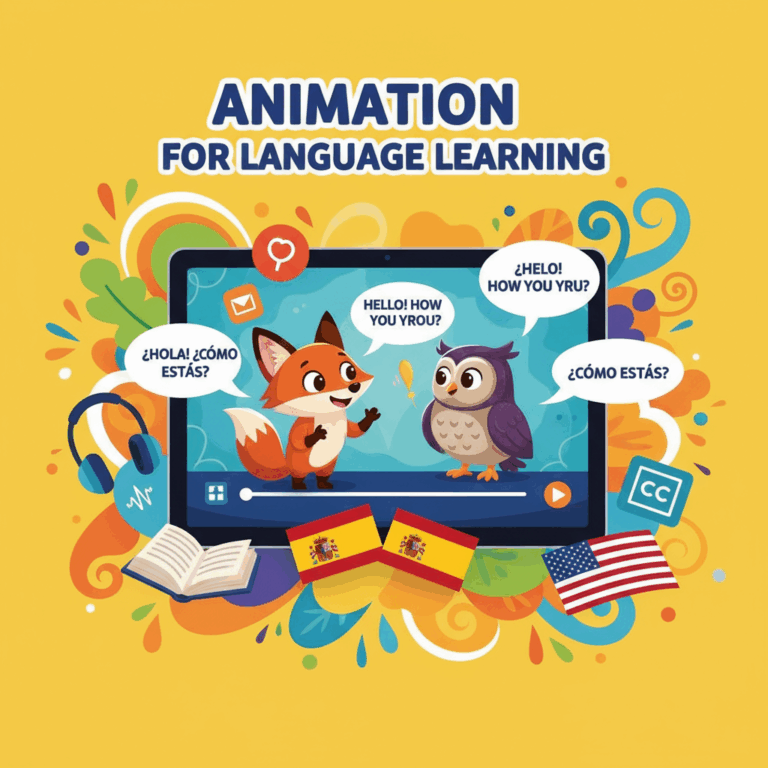Benefits of learning with animated films
The animated films They are an effective tool for learning languages, as they combine entertainment with simple language that facilitates understanding.
Furthermore, they offer a strong visual support which reinforces learning and helps to internalize vocabulary and grammar naturally.
Simple language and repetition to facilitate understanding
Animated films often use a plain language and simple phrases that promote understanding for beginners in the language.
The repetition Frequent repetition of words and phrases helps reinforce learning and facilitates the memorization of grammatical structures.
This approach is beneficial for both children and adults, as it provides an everyday context that connects the language to real-life situations.
Visual support and emotional association for understanding
The gesturesFacial expressions and visual context help to understand the meaning without the need for translation, facilitating the assimilation of the language.
The emotional association Through scenes such as sadness or joy, it strengthens the connection between word and context, enriching auditory comprehension.
This method simulates the natural learning of the mother tongue, making study more intuitive and effective.
Ideal animated films and techniques for study
Choose the suitable animated films The student's level is key to effective language learning.
In addition, implementing specific techniques such as the use of subtitles and active repetition enhances vocabulary and pronunciation acquisition.
Selection of films for different levels
For beginners, it's ideal to start with films that have basic vocabulary and simple plots, such as those aimed at children.
As the student progresses, it is recommended to choose animations with more complex dialogues that challenge and expand their understanding.
This gradual progression allows the content to be adapted to the level, maintaining motivation and avoiding frustrations during learning.
Using subtitles to improve pronunciation and vocabulary
Activating subtitles in the original language or the language being studied helps to connect the pronunciation with writing of words.
Subtitles facilitate the identification of new words and expressions, while reinforcing auditory and visual recognition.
This practice improves comprehension and accustoms the ear to the specific sounds of the language, promoting oral fluency.
Repetition and active practice of dialogues and phrases
Repeating scenes or dialogues allows you to fix grammatical structures and vocabulary in your memory in a natural and entertaining way.
Practicing pronunciation by imitating characters enhances oral production and increases confidence in communicating.
This active technique engages the student dynamically, promoting a deeper and more lasting assimilation of the language.
Cultural aspects present in animation
Animated films offer much more than vocabulary and grammar; they reflect the cultural expressions and customs specific to the language being studied.
This cultural component is essential to understanding the actual use of the language and how native speakers communicate in different contexts.
Exposure to expressions and customs of the language
When watching animated films, the student encounters idioms, set phrases and typical gestures that represent the culture of the language.
Furthermore, these films show social customs and traditions that enrich the learning experience and increase intercultural understanding.
This exposure helps adapt language to real-life everyday situations, allowing for a more natural and contextualized use of the learned language.
Strategies for effective learning with animation
To maximize learning with animated films, it is essential integrate active techniques that facilitate language retention and mastery.
It is also recommended to follow a appropriate progression in the material, starting with simple content and progressing to more complex levels.
Integrate printed phrases and pronunciation practice
Printing out key phrases from movies and practicing their pronunciation by following the characters' model helps improve diction.
This technique makes learning more tangible and allows you to focus on specific sounds and important grammatical structures.
Repeating phrases aloud facilitates memorization and increases confidence in using the language in real-life situations.
Gradual progression from children's materials to advanced materials
It is recommended to start with films aimed at children, which offer basic vocabulary and simple phrases.
As language skills increase, the student can move on to animations with complex dialogues and more elaborate themes.
This progression maintains motivation and ensures increasing understanding without overburdening the learner.






